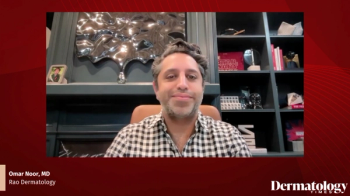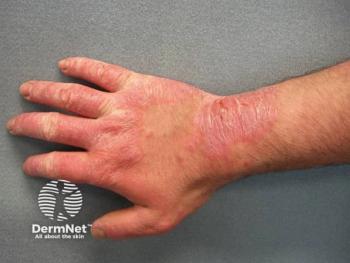
CHE Severely Impacts Work and Daily Functioning
Key Takeaways
- CHE affects over 13% of adults, often underdiagnosed, with symptoms complicating timely diagnosis. It requires consistent terminology and validated severity scoring tools.
- Distinct immune profiles in CHE subtypes offer new therapeutic opportunities, such as JAK inhibitors, highlighting the need for precision treatment.
Explore the complexities of chronic hand eczema, its impact on quality of life, and emerging treatment options in this insightful review.
A recent narrative review published in Acta Dermato-Venereologica offers critical insights into the underrecognized and undertreated condition of chronic hand eczema (CHE), urging clinicians to reconsider how they identify, manage, and support patients with this burdensome skin disease. Authored by a panel of international experts including Sonja Molin, MD, Emma Guttman-Yassky, MD, PhD, Jacob Thyssen, PhD, and Anthony Bewley, BA (Hons) MBChB FRCP, the review calls attention to the multifaceted pathophysiology, psychosocial toll, and substantial unmet clinical needs associated with CHE.1
More Than Just a Skin Condition
Recent data highlight CHE as a prevalent inflammatory disorder affecting over 13% of adults in some populations, with the majority of these cases qualifying as chronic. Defined by persistence beyond 3 months or recurrence at least twice annually, CHE often presents with a complex array of symptoms—itching, pain, erythema, fissures, and vesicles—that mimic other dermatoses like psoriasis or tinea, complicating timely diagnosis.2
The new review emphasizes that despite its frequency and impact, CHE remains poorly understood and frequently underdiagnosed, even among clinicians. One key takeaway is the call for consistent use of the term “CHE” in clinical settings, along with broader adoption of validated severity scoring tools and more nuanced subtype identification.1
Immune Pathways Reveal New Therapeutic Opportunities
A major focus of the recent review is the evolving understanding of CHE’s immunopathogenesis. Distinct from atopic dermatitis (AD), CHE subtypes—irritant contact dermatitis, allergic contact dermatitis, atopic hand eczema, and protein contact dermatitis—display divergent immune profiles involving Type 1, Type 2, and even Type 17 cytokine signaling. Many of these inflammatory mediators converge on the JAK/STAT pathway, a finding that supports the recent development of targeted topical and systemic therapies.
In fact, delgocitinib cream—a topical pan-JAK inhibitor—was recently approved for moderate to severe CHE, marking a new era of precision treatment. The approval followed evidence that interferon signaling and necroptosis are more prominent in CHE than in AD, suggesting distinct therapeutic targets.
Real-World Impact: Psychosocial and Economic Burden
The recent publication doesn’t stop at molecular pathways. It brings into sharp focus the real-world impact of CHE, describing a disease that can devastate quality of life and professional stability. Patients report significant embarrassment, self-isolation, and functional impairment, particularly when disease flares affect manual dexterity or interpersonal contact. Clinically significant anxiety and depression are disproportionately high among individuals with CHE compared to patients with other skin conditions.
From an economic perspective, CHE incurs substantial direct and indirect costs. Up to 25% of patients report changing or leaving their jobs due to their disease, and many experience presenteeism—working through flares at reduced productivity due to fear of job loss. The review estimates societal costs per patient in Europe may exceed €7,700 annually.
Current Treatments Fall Short
Despite the severity and complexity of the disease, therapeutic options for CHE remain limited. The review highlights that while topical corticosteroids are a mainstay of treatment, many patients experience adverse effects such as skin atrophy. Alarmingly, more than 75% of patients surveyed expressed a preference for non-steroidal alternatives, and real-world evidence shows low drug survival rates for systemic agents like cyclosporine and methotrexate due to side effects or inadequate efficacy.
Newer therapeutic strategies, including off-label use of AD biologics and JAK inhibitors, are gaining traction but require further validation in CHE-specific populations. As noted in the review, there is an urgent need for head-to-head trials, biomarker-driven stratification, and real-world evidence to guide treatment decisions.
Clinical Implications and Next Steps
This comprehensive review offers clinicians a timely reminder that CHE is a distinct, burdensome disease that demands early recognition, precise classification, and multidisciplinary care. Clinicians are encouraged to go beyond symptom control by exploring occupational risk factors, psychosocial support needs, and patient-reported outcomes.
Importantly, the authors recommend universal patch testing for patients with persistent or treatment-resistant disease and call for a shift toward holistic, personalized care. The findings also underscore the need for future research into disease biomarkers and molecular profiling that could facilitate better subtype targeting and improve therapeutic outcomes.
As treatment options slowly expand and awareness increases, clinicians are uniquely positioned to close the care gap for patients with CHE—starting with a deeper understanding of this complex condition as illuminated by this important new research.
References
- Molin S, Guttman-Yassky E, Thyssen JP, Bewley A. Chronic hand eczema, real world, and patient centricity: A narrative review. Acta Derm Venereol. 2025 Apr 2;105:adv42596. doi: 10.2340/actadv.v105.42596. PMID: 40171832; PMCID: PMC11977413.
- Quaade AS, Alinaghi F, Dietz JB, Erichsen CY, Johansen JD. Chronic hand eczema: A prevalent disease in the general population associated with reduced quality of life and poor overall health measures. Contact Dermatitis. 2023;89(6):453-463. doi:10.1111/cod.14407
Newsletter
Like what you’re reading? Subscribe to Dermatology Times for weekly updates on therapies, innovations, and real-world practice tips.



















